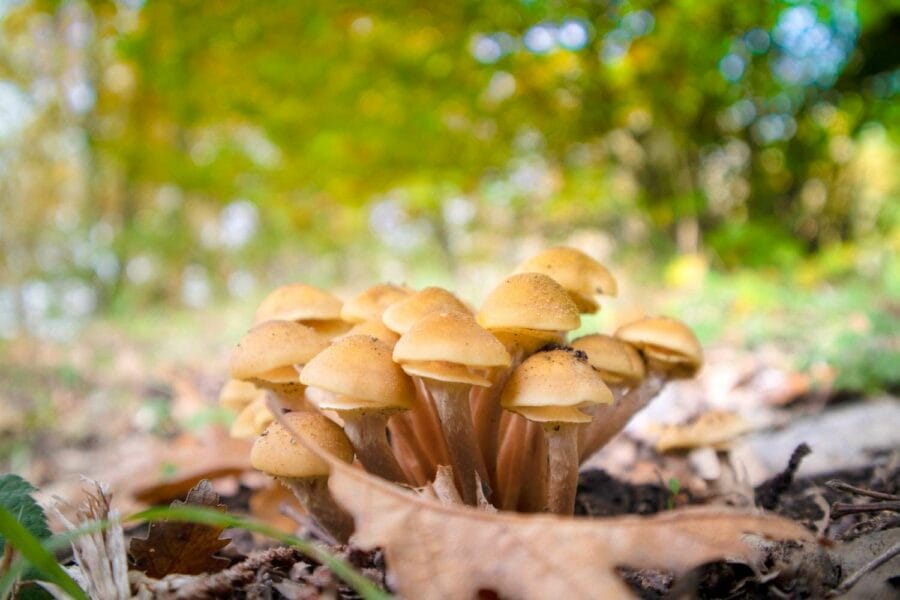Psilocybin is a psychoactive substance found in magic mushrooms, which is often used recreationally for its euphoric and hallucinogenic effects.
Beyond its mind-altering properties, research has been conducted into the potential benefits of this compound for relieving chronic pain.
This article discusses a case study that investigates how microdosing mushrooms might assist in alleviating chronic pain.
Key Takeaways:
- Microdosing mushrooms could potentially provide both immediate and sustained pain relief.
- Compared to traditional pain medications, microdosing psilocybin tends to have fewer side effects when given in small quantities.
- Psilocybin interacts with the serotonin 2A (5-HT2A) receptors, which may help mitigate pain, among other conditions.

The Study
The research titled “Microdosing Psilocybin for Chronic Pain: A Case Series” was carried out by Dr. Matthew Lyes and his team from the Division of Pain Medicine in the Department of Anesthesiology at the University of California, San Diego. They centered their study on three patients who were self-administering small amounts of psilocybin to manage their chronic pain symptoms.
Three Patients, One Result – Chronic Pain Relief
Patient # 1
| AGE/ GENDER: | 37 Male |
| TYPE OF PAIN: | Neuropathic pain occurring below the site of a spinal cord injury. |
| PAIN LEVEL: | Initially 4 to 5/ 10, increasing to 8/ 10 later in the day |
| PSILOCYBIN DOSE: | 250 mg of ground mushroom for less than 6 months |
| RESULT: | Discontinuation of prescribed pain medication, decrease in muscle spasms, and improvement in bowel movement efficiency. No signs of rebound pain or withdrawal symptoms were observed. |
| The patient reported that while his regular medications only managed to lessen the pain, psilocybin effectively eliminated it, reducing his average pain level from 5 to 0. | |
Case Study: Second Patient
| AGE/ GENDER: | 69-year-old Female |
| PAIN TYPE: | Complex Regional Pain Syndrome (CRPS) |
| PAIN INTENSITY: | Typically fluctuates between 5 to 7 out of 10, but can increase with physical activity and during pain flare-ups |
| PSILOCYBIN DOSAGE: | A daily dose of 500 mg for a span of 7 to 10 days with rest intervals (2 to 3 days) over the course of a year. Dosage is upped to 750 mg to 1 gram during pain flare-ups |
| EFFECTS: | Pain reduction by 80% lasting for 3-4 hours, slowly returning to initial levels after 12 hours. Full pain relief (90%-100%) lasts 6-8 hours, reverting back to initial levels after 18 hours. |
| The patient notes a diminished appetite without any feeling of nausea. A sense of disorientation or instability in walking is observed when the dosage is increased (750 to 1000mg). | |
Case Study: Third Patient
| AGE/ GENDER: | 40-year-old Female |
| PAIN TYPE: | Lumbar radiculopathy and neuropathic pain |
| PAIN INTENSITY: | 8 out of 10, which can spike to 10 out of 10 during physical activities |
| PSILOCYBIN DOSAGE: | 1000 mg in the form of a mushroom chocolate bar consumed every two months. |
| EFFECTS: | Significant relief from pain without any psychoactive effects. An increase in flexibility and functionality is observed. Pain slowly returns to initial levels over a period of 2-4 weeks. Regular dosing enhances pain management. |
| The patient does not experience any notable physical, cognitive, or behavioural side effects. Her mood remains stable. She maintains her regular dosage of her SSRI for depression management throughout the psilocybin treatment period. | |
Exploring Pain Management through Psilocybin
Chronic pain, both physical and emotional, results from the reinforcement of certain neural pathways due to continuous somatic and visceral pain signals, caused by peripheral and central sensitization. Psychedelics like psilocybin have the potential to ‘reset’ the brain regions linked with neuropathic conditions by activating 5-HT2A receptors.
One patient reported experiencing pain relief for several weeks, suggesting that after directly stimulating the 5-HT2A receptors, a central regulation of pain perception and
Adaptability of synapses.
Potential Adverse Effects of Psilocybin Vs. Traditional Painkillers
| PSILOCYBIN (Based on Studies) | TRADITIONAL PAINKILLERS |
| Muscle spasms | Nausea |
| Decreased appetite | Gut discomfort |
| Confusion | Headaches |
| Unsteady gait | Addiction |
| No mood changes | Drowsiness |
Prospective Future Studies on Psilocybin
The research group, after analyzing the experiences of three subjects, has identified potential areas for future investigation due to their prospective benefits.
- Microdoses of psilocybin could provide immediate and possibly long-lasting relief from neuropathic pain, without resulting in physical tolerance or dependence.
- Examine the outcomes of different treatment procedures when combined with psilocybin. For example, patient # 3 reported an increased pain-relieving effect when psilocybin was used in conjunction with physical therapy.
- Small doses of psilocybin may alleviate pain even without psychotherapy, as demonstrated in this case study. The researchers propose that incorporating therapeutic guidance could possibly enhance or extend the therapeutic effects.
Constraints of the Study
Despite the encouraging outcomes observed in the subjects, it’s crucial to acknowledge the study’s limitations.
- The small number of participants may not sufficiently represent all individuals dealing with neuropathic pain.
- The study lacked subjects who showed no response to psilocybin.
- There were no assessments conducted before and after the treatment to evaluate the impact of psilocybin on mental health disorders such as depression and anxiety.
- Most of the data were self-reported by the participants.
- The interviewer’s presence and possible bias towards psilocybin could have influenced the participants’ responses.
- The study did not examine the effect of the placebo.
- The study failed to quantify the psilocybin content in each mushroom.
Utilizing Mushrooms for Microdosing
Within the scope of this study, the first two patients consumed a minuscule quantity of powdered psilocybin, derived from dried mushrooms. In contrast, the third patient incorporated it into chocolate. Numerous psilocybin microdosing products are available on the market, and we have gathered a short list of some of these below.
Dehydrated Mushrooms
Despite the study not mentioning the specific strain employed, the one listed below is a suitable option for those new to the practice.
- Golden Teacher: This strain is prevalent and frequently observed among magic mushrooms.
- Amazonian Cubensis: Renowned for its user-friendliness, it may also offer cognitive enhancements.
- Cambodian: Microdosing with Cambodian cubensis mushrooms may improve focus, social awareness, and mood.
Capsules for Microdosing
- Euphoria Psychedelics – Micro Calm Capsules: This concoction includes components such as Ashwagandha, Reishi, CBD, Valerian root, and Psilocybin Mushrooms, all of which have been scientifically shown to diminish anxiety and stress levels.
- Ground Sounds – Microdose Capsules – Champion Lover: This appealing blend provides three dosage levels: 50mg, 100mg, or 250mg of pure psilocybin, combined with reishi, cacao, cordyceps, and maca.
- Kind Stranger – Brighten Capsules 250mg: These capsules are made with the Golden Teacher strain, reputed for enhancing mental clarity, boosting creative thinking and improving focus.
Psilocybin for Pain Relief
Although the investigation into mushrooms’ analgesic properties is yet in its infancy, anecdotal accounts and small-scale case studies are yielding promising results.
Such instances underscore the necessity for additional research into the potential advantages of psilocybin, class=”wp-block-list”>
What are the possible side effects?
Possible side effects may include nausea, headache, increased heart rate, and potential psychological effects such as anxiety and paranoia. Long-term effects are currently unknown due to a lack of longitudinal studies.
Can you overdose on psilocybin?
While it’s unlikely to overdose on psilocybin, consuming large amounts can lead to a challenging experience with potential psychological distress. Therefore, it’s advised to start with a small dose and gradually increase if needed.
Is it possible to become addicted to psilocybin?
Current research suggests that psilocybin does not cause physical dependence or addiction. However, it’s always important to approach its use with caution and responsibility.
Psilocybin has shown promise, especially in the field of chronic pain management.
Even before the wide acceptance of psilocybin in pain relief, the promising reports from case studies have been a source of hope for those living with chronic pain.
Frequently Asked Questions
What effects can microdosing psilocybin have?
Primarily, psilocybin activates a serotonin receptor known as “5-HT2A” in the prefrontal cortex, causing two main effects:
- Creation of “Brain-Derived Neurotrophic Factor” (BDNF)
- Enhancement of “Glutamate” transmission
Furthermore, psychedelics promote connections between brain regions that usually do not interact much. This unique connectivity is a result of the ability of psychedelics to decrease the activity of the “Default Mode Network” (DMN), which is associated with cognitive functions such as daydreaming, introspection, and pondering the past and future.
What is the most recognized benefit of microdosing mushrooms?
Microdosing can potentially enhance mood, productivity, creativity, and focus. Its most extensively researched benefit is its influence on mental health.
In November 2022, COMPASS Pathways, a mental health company, disclosed the outcomes of their comprehensive phase 2b trial, a randomized and double-blind study. Their findings suggested that a single dose of psilocybin resulted in significant reductions in depressive symptoms compared to a placebo. Participants who received a higher dose of 25 milligrams displayed a lasting antidepressant response at the twelve-week follow-up.
A study published in the Psychiatry Research Journal indicated that psilocybin is more effective than traditional antidepressant treatments.
How do you determine your dosage?
Start with a 0.1-gram dose of psilocybin mushrooms on the first day. If the desired effects are not achieved, you can slowly increase your dose by 0.05 grams on subsequent microdosing days until you find your ideal level.
Individuals with a history of using psychotropic substances may need to increase the dosage to 0.5 grams to achieve the desired effects.
What precautions should be taken before consuming mushrooms?
- Allocate time to understand the purpose behind microdosing on a particular day.
- Take a moment to self-reflect and connect with your current emotional or mental state. Identify the emotions or mindset you believe would be advantageous for you that day.
- Upon clearly defining your goals, write them down. Expressing your objectives as affirmations can significantly support your continuous growth.
- Direct your focus towards the experience you wish to attain, rather than what you want to steer clear of.
- Ingest it on an empty stomach, preferably an hour before your first meal of the day.
How often should you consume microdoses of mushrooms?
There are several well-grounded protocols that suggest organized microdosing schedules for psychedelics. These protocols mainly vary in the number of “off” days they include, which are the days you abstain from microdosing.
The commonly suggested protocols advise incorporating 1-3 rest days between microdoses. This aligns with the body’s natural tolerance mechanisms. The three protocols under consideration here are the Fadiman Protocol, the Stamets Stack, and intuitive microdosing.




